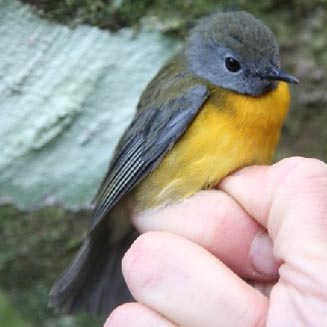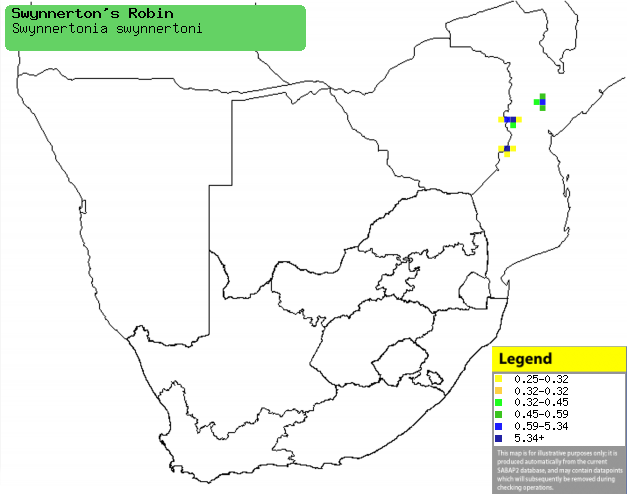|
Swynnertonia swynnertoni (Swynnerton's
robin)
Bandkeeljanfrederik [Afrikaans]; Swynnertons sterrepaapje [Dutch];
Rougegorge de Swynnerton [French]; Swynnertonrötel [German];
Pisco-de-peitilho [Portuguese]
Life
> Eukaryotes >
Opisthokonta
> Metazoa (animals) >
Bilateria >
Deuterostomia > Chordata >
Craniata > Vertebrata (vertebrates) > Gnathostomata (jawed
vertebrates) > Teleostomi (teleost fish) > Osteichthyes (bony fish) > Class:
Sarcopterygii (lobe-finned
fish) > Stegocephalia (terrestrial
vertebrates) > Tetrapoda
(four-legged vertebrates) > Reptiliomorpha > Amniota >
Reptilia (reptiles) >
Romeriida > Diapsida > Archosauromorpha > Archosauria >
Dinosauria
(dinosaurs) > Saurischia > Theropoda (bipedal predatory dinosaurs) >
Coelurosauria > Maniraptora > Aves
(birds) > Order: Passeriformes
> Family: Muscicapidae
 |
|
|
Swynnerton's robin, Udzungwa Mountains
National Park, Tanzania. [photo
Louis Andre Hansen ©] |
|
Distribution and habitat
Highly localised, only occurring around two mountains in
Tanzania and in Zimbabwe's eastern highlands, as well as on Mt Gorongosa,
Mozambique. It generally prefers the undergrowth of evergreen forest, especially
when it has dragon-trees (Dracaena).
|
 |
|
Distribution of Swynnerton's robin in southern
Africa, based on statistical smoothing of the records from first SA Bird
Atlas Project (©
Animal Demography unit, University of
Cape Town; smoothing by Birgit Erni and Francesca Little). Colours range
from dark blue (most common) through to yellow (least common). |
Food
It mainly eats beetles and ants supplemented with fruit,
doing most of its foraging on the ground, flicking through leaf litter in search
of food, and often catching the prey fleeing from an approaching swarm of
African driver ants (Anomma wilverthi). The following food items have been recorded
in its diet:
Breeding
- The nest is an open cup built of dead leaves, tendrils, rootlets, moss and
leaf midribs and lined with the dark plant fibres found at the bases of tree
ferns (Cyathea) fronds. It is typically placed at the base of
dragon-tree (Dracaena) leaf, or alternatively in the hollow of a tree
stump, a forked stem of a shrub or on a platform formed by interlaced liana
stems.
- Egg-laying season is from October-January, peaking from
November-December.
- It lays 2-3 eggs, which are incubated solely by the female for about
14-15 days.
- The chicks are brooded by the female for the first 7-9 days of their
lives, all the while the male passer her food, he then feeds it to the
young. The female joins the male in foraging after she has finished brooding
the chicks, who leave the nest when they are about 14 days.
Threats
Rare, due its localised distribution.
References
-
Hockey PAR, Dean WRJ and Ryan PG 2005. Roberts
- Birds of southern Africa, VIIth ed. The Trustees of the John Voelcker
Bird Book Fund, Cape Town.
|
